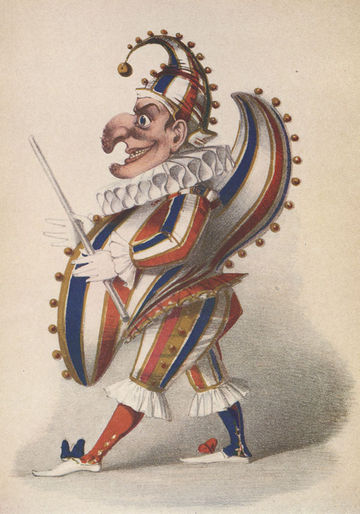Annotation:Punchinello (1): Difference between revisions
No edit summary |
No edit summary |
||
| Line 3: | Line 3: | ||
<p><font face="garamond, serif" size="4"> | <p><font face="garamond, serif" size="4"> | ||
'''PUNCHINELLO.''' AKA – “Punchinello’s Hornpipe.” AKA and see “Jock and Tam,” “Lady Susan Montgomery’s Hornpipe,” “Rusty Gulley [2],” “Three Case Knives,” “Three Rusty Swords.” English, “Old” Hornpipe (3/2 time). G Minor. Standard tuning (fiddle). AABB (Callaghan): AABBCC (Howe). This air appears in the '''Musical Miscellany''' (London, 1731). A melody by this name “Punchinello’s Hornpipe, or Three Rusty Swords” appears in Offord’s '''John of the Greeny Cheshire Way''', another setting of which appears in the same volume as “Three Case Knives.” Punchinello, shortened to Punch, was a favorite puppet character for a few centuries. The name Punchinello is a variant of the names Pulcinella, Polichinello, Pollicinella and Polichinelle, and derived from the Italian ''pulcino'', a chicken, which refers to the character’s beak-like nose and his chirpy voice. On the comic stage he was a servant, like the character Harlequin, in the Commedia dell’arte. | '''PUNCHINELLO.''' AKA – “Punchinello’s Hornpipe.” AKA and see “Jock and Tam,” “Lady Susan Montgomery’s Hornpipe,” “Rusty Gulley [2],” “Three Case Knives,” “Three Rusty Swords.” English, “Old” Hornpipe (3/2 time). G Minor. Standard tuning (fiddle). AABB (Callaghan): AABBCC (Howe). This air appears in the '''Musical Miscellany''' (London, 1731). A melody by this name “Punchinello’s Hornpipe, or Three Rusty Swords” appears in Offord’s '''John of the Greeny Cheshire Way''', another setting of which appears in the same volume as “Three Case Knives.” Punchinello, shortened to Punch, was a favorite puppet character for a few centuries. The name Punchinello is a variant of the names Pulcinella, Polichinello, Pollicinella and Polichinelle, and derived from the Italian ''pulcino'', a chicken, which refers to the character’s beak-like nose and his chirpy voice. On the comic stage he was a servant, like the character Harlequin, in the Commedia dell’arte. | ||
[[File:punch2.jpg|360px|thumb|left|Punch, mid-19th century. "The comic character of Punch takes many forms but most have some of the following characteristics: short stature, large belly, hooked nose, jutting chin, prominent hunchback, a ferocious temper and squeaking voice. His distinctive costume will often feature a tall, conical hat, an oversized ruff, large buttons down his striped front and carrying a wooden slapstick. | [[File:punch2.jpg|360px|thumb|left|Punch, mid-19th century. "The comic character of Punch takes many forms but most have some of the following characteristics: short stature, large belly, hooked nose, jutting chin, prominent hunchback, a ferocious temper and squeaking voice. His distinctive costume will often feature a tall, conical hat, an oversized ruff, large buttons down his striped front and carrying a wooden slapstick" [http://www.libraryofbirmingham.com/punchandjudy?nojs#].]] | ||
<br> | <br> | ||
<br> | <br> | ||
Revision as of 00:22, 4 August 2016
Back to Punchinello (1)
PUNCHINELLO. AKA – “Punchinello’s Hornpipe.” AKA and see “Jock and Tam,” “Lady Susan Montgomery’s Hornpipe,” “Rusty Gulley [2],” “Three Case Knives,” “Three Rusty Swords.” English, “Old” Hornpipe (3/2 time). G Minor. Standard tuning (fiddle). AABB (Callaghan): AABBCC (Howe). This air appears in the Musical Miscellany (London, 1731). A melody by this name “Punchinello’s Hornpipe, or Three Rusty Swords” appears in Offord’s John of the Greeny Cheshire Way, another setting of which appears in the same volume as “Three Case Knives.” Punchinello, shortened to Punch, was a favorite puppet character for a few centuries. The name Punchinello is a variant of the names Pulcinella, Polichinello, Pollicinella and Polichinelle, and derived from the Italian pulcino, a chicken, which refers to the character’s beak-like nose and his chirpy voice. On the comic stage he was a servant, like the character Harlequin, in the Commedia dell’arte.

Ellias Howe 'modernized' the meter to 6/8 time. The melody is similar to "Dusty Miller (6).”
Source for notated version:
Printed sources: Callaghan (Hardcore English), 2007; p. 77. Howe (1000 Jigs and Reels), c. 1867; p. 156.
Recorded sources:
